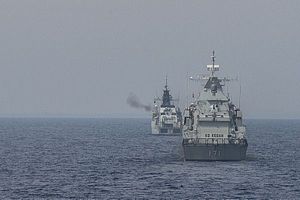On September 18, the United States and Malaysia kicked off a maritime training activity at Lumut Naval Base. The interaction, which came just days after a summit meeting between the leaders of the two countries, was testament to the ongoing interactions between the two sides in the defense realm.
As I have noted previously, despite some lingering differences, the United States and Malaysia enjoy a strong defense relationship, as manifested across a range of areas such as counterterrorism and maritime security, and through a variety of means including visits, exchanges, and exercises (See: “Malaysia’s Approach to the South China Sea and Implications for the United States”). With respect to exercises, these include Malaysia’s participation in multilateral ones like Pacific Partnership and the Southeast Asia Cooperation and Training (SEACAT) as well as bilateral ones such as Exercise Keris Strike.
The development of bilateral defense ties were also part of the conversation during last week’s summit meeting between Malaysian Prime Minister Najib Razak and U.S. President Donald Trump on September 12 as well as the related meetings and engagements by both sides (See: “The Real Test for US-Malaysia Relations in the Trump Era”).
On September 18, the United States and Malaysia began yet another bilateral exercise. Interestingly, though, this year the exercise was conducted as a “Maritime Training Activity” (MTA) rather than as part of the Cooperation Afloat Readiness and Training (CARAT) exercise series now underway that includes nine South and Southeast Asian countries as would usually be the case during this time. The 23rd CARAT series had kicked off in Sattahip, Thailand, on May 29, and had continued on, with the Indonesia leg being launched last week.
The redesignation from a part of the CARAT series to a different name as we saw in this U.S.-Malaysia case is something that has occurred this year with a few other Southeast Asian states as well. In the case of the Philippines, following a review carried out by President Rodrigo Duterte last year, CARAT was redesignated as an MTA. As I noted, the United States and the Philippines had carried out the first of their new MTAs earlier this year, with no significant change in the actual level of participation by Washington and an engagement in the Sulu Sea (See: “What’s With the New US-Philippines Sulu Sea Patrols Under Duterte?”).
And in the case of Singapore, this year witnessed the inaugural iteration of a new and more complex exercise Pacific Griffin, which was the first bilateral naval exercise between the two sides taking place outside of Singapore (See: “What’s in the New US-Singapore Maritime Exercise in Guam?”). Cambodia, meanwhile, has been excluded out of the CARAT series for now, which is no surprise given the state of U.S.-Cambodia relations more generally (See: “Why Did Cambodia Just Downgrade US Military Ties Again?”).
No explanation was publicly given for why this U.S.-Malaysia interaction was designated an MTA. A source familiar with the planning of the exercise said that the designation was chosen because the interaction this year was a strictly naval exercise with no marine or land component. Malaysia officially remains part of the CARAT series and CARAT exercises between the two sides are also expected to continue in the future.
As for the engagement itself, the U.S. Navy said nearly 300 U.S. and Malaysian sailors aboard the littoral combat ship USS Coronado, Kasturi-class corvette KD Lekir, and Lekiu-class frigate KD Lekiu (F30) were participating in the exercise.
As is traditionally the case, the exercise involves both ashore and at-sea phases. Sailors from both navies will engage in a range of activities including visit, board, search and seizure (VBSS) trainings, division tactics (DIVTACS) to enhance cooperative fleet maneuvers, a gunnery exercise, flight operations with the U.S. Navy’s MH-60S and Royal Malaysian Navy’s Super Lynx helicopters, and a search and rescue exercise (SAREX).
































